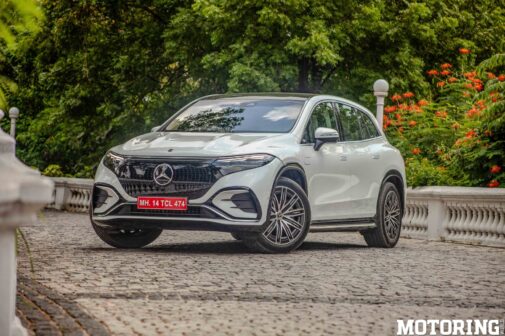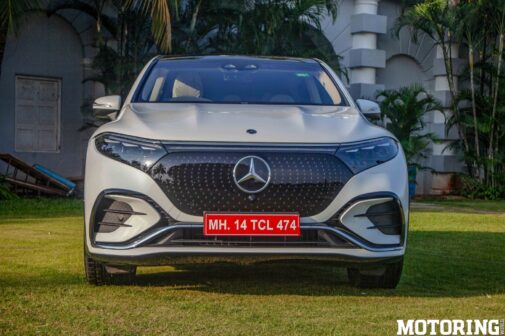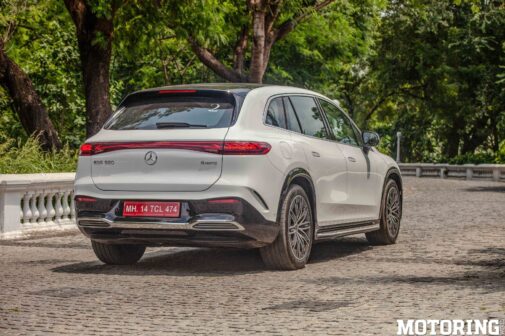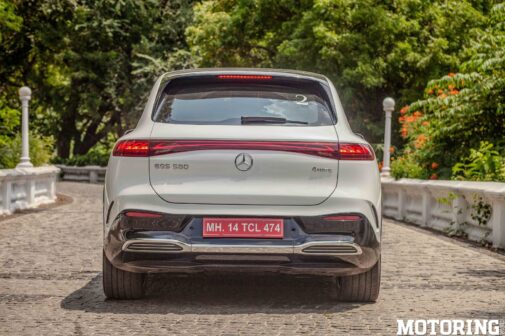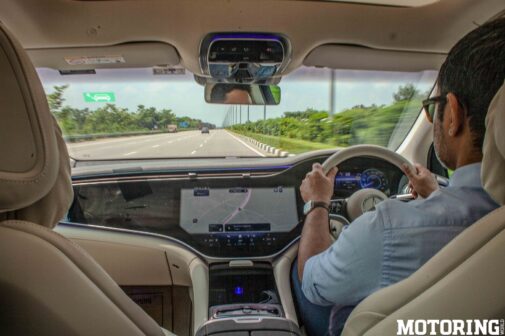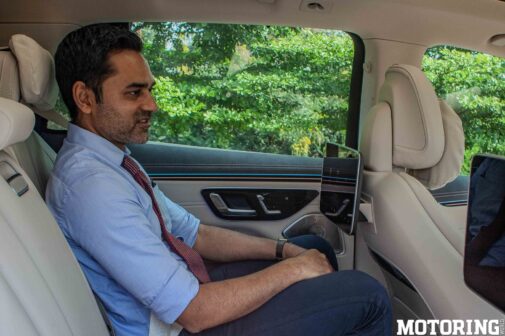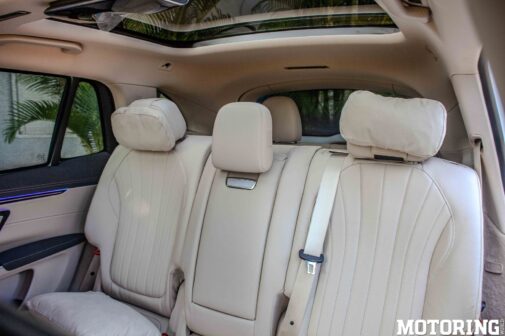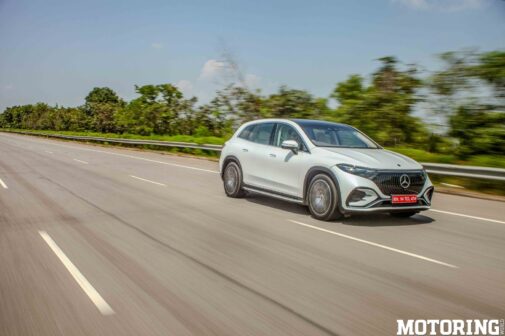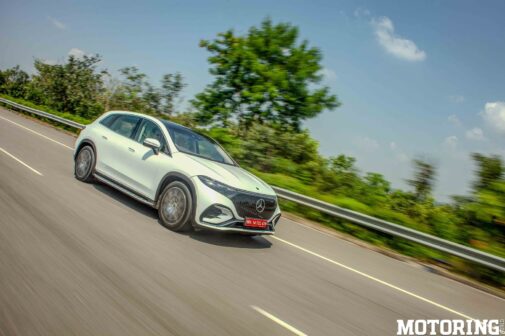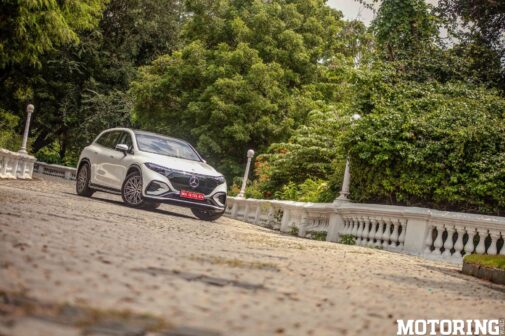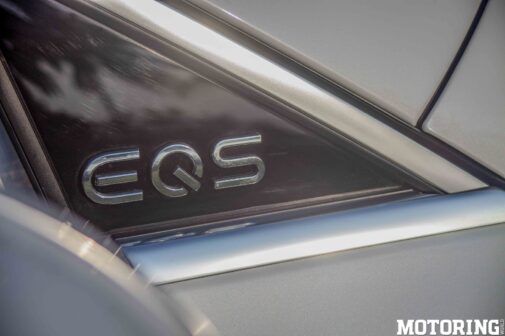What weighs 2,850 kg, is 17 feet long and over 6 feet wide and can go from 0-100 kph in 4.7 seconds? Absolutely no prizes for guessing, but it’s the car in these pages. Honestly, those figures border on the ridiculous – nothing this large and heavy should have any right to be so rapid, but there you have it. Physics? Pah, what’s that?
In order to break these well-established laws, Mercedes has taken its EQS sedan and added stilts, giving it a height of just over five and a half feet and ground clearance of 222 mm, which is genuine SUV territory; 21-inch AMG wheels come as standard and fill out the arches good and proper. This is one hell of an imposing machine, make no mistake, even though its exterior design is very much an acquired taste (a taste that costs Rs 1.5 crore to acquire, mind you). The reason the EQS range of cars look like they’re melting is down to one reason, and one reason only – coefficient of drag. The SUV’s slightly bloated look belies the fact that its Cd is an astonishing 0.25, which is what matters with EVs that are this big. Still, that doesn’t hide the fact that there’s still a massive surface area up front that needs a ton of power to move, but overall, its design is the result mainly of practicality, not aesthetics.
You won’t mistake this car for anything other than a Mercedes, mainly because there are literally hundreds of three-pointed stars on its front. The large central logo is surrounded by a huge piano-black element, which fuses into the headlights and has over 200 little logos on it. The headlights, which Merc calls Mercedes Digital Light, are matrix units and have a variety of functionalities. Naturally, they light up the road, but they also have things like adaptive high-beam assist and topography levelling, which keeps the range of the lights as even as possible through height differences in the terrain in front of the car. The lights are connected with an LED bar, which stays on all the time and gives the car a unibrow of sorts.
In profile, there are no really distinctive features on the car; it’s a bland design, tailored for maximum aero efficiency, and from this view it looks more like an estate than an SUV. All four door handles sit flush with the body and pop out when you open the doors, aiding the drag figure even more; only the ORVMs block air flow, and even those have been designed to be as slippery as possible. Running boards are present, with Merc logos on them, and the fact that it has 210 mm of clearance isn’t immediately evident, so props to the designers for cleverly concealing this.
At the back, another huge LED bar runs the width of the hatch, with the same light signature as the EQS and EQE sedans; I have to say it looks smashing at night; two faux ‘exhaust’ tips are (somewhat pointlessly) present at the bottom. The logo in the middle serves as the opener for the electric tailgate, and overall, every surface on the EQS SUV is rounded off, smoothed up and pointed downwards – hence the ‘melting’ look. Still, as I mentioned earlier, this thing has tremendous heft on the road, and will cause lesser vehicles to get out of the way if they see it coming in their rear view.
Nobody is going to buy this car to win beauty pageants, however – it’s what’s inside that they will be interested in, and they will certainly not be disappointed. The cabin is huge, for starters, and although it mirrors the EQS sedan, it looks and feels a notch above in terms of quality (which is saying something). As you would expect, the gigantic 56-inch Hyperscreen is the first thing that stands out when you get inside. It’s basically a fully digital, high resolution dashboard, with a section for the front passenger, the main infotainment screen and the instrumentation. It looks impressive, no doubt, but I’m an old codger and would literally pay extra to have no screens and a full complement of high quality switches and dials; new-age buyers will appreciate it, however. It’s a giant fingerprint and smudge magnet, so keeping it clean will probably require hiring someone just for that task.
In every other regard, the cabin is as luxurious, high quality and feature-packed as you would think – except for a couple of curious omissions. There is no 2nd row seat ventilation (only heating) and massage function, which is odd given that owners are going to sit almost exclusively in the back. If a Hyundai Alcazar can offer cooled rear seats , surely Mercedes-Benz can; it’s something for the firm to think about, at any rate. Other than the Hyperscreen, you get the full laundry list – programmable ambient lighting, heated/ventilated/massage front seats, a massive sunroof, plush leather upholstery, wireless charging, a glorious Burmester audio system, a huge cooled storage bin below the centre console (with many other storage spaces), a fingerprint scanner to customise settings for you, lots of USB-C charging ports, wireless Apple CarPlay and Android Auto, very spacious front and 2nd row seats with some smashing neck pillows, rear entertainment screens with headphones and a removable tablet controller and several more; suffice to say that you won’t find yourself complaining about the cabin, for the most part.
What you may have some niggles with is the 3rd row of seats, which are a bit difficult to get into and are small even for children; also, the placement of the batteries below the 2nd row means that you sit with your legs slightly lifted, which can become tiring over a long distance. In terms of practicality, there’s enough space for a few suitcases even with the 3rd row up; with it folded, you get 880 litres of cargo space. In case you want to convert your luxury SUV into a U-Haul truck, you can fold the 2nd row as well, to free up 2,100 litres of room.
At the business end of things, the EQS SUV in 580 4Matic guise comes with two permanent synchronous motors, one each at the front and back; all-wheel drive and rear-wheel steering are standard. There’s a huge 122 kWh battery pack powering them, and with 536 bhp and 87.4 kgm of torque, this behemoth is beefier than a Porsche 911 GT3 RS. As you can imagine, acceleration is suitably immense at any kind of speed; a 100 kph run from standstill takes less than five seconds, and even with a rolling start at around 80 kph, it’s brutal. As a matter of fact, it’s robust enough to cause an unbelted photographer in the rear seat – shooting footage of me driving – to tumble backwards, and for his phone to fly out of his hand (just ask Amit, if you don’t believe me). Nobody will need more motive force than the EQS offers, I can tell you; it’s as assured at gentle city speeds as it is at highway-crushing. Top speed is limited to 210 kph, which is probably a good thing. Mercedes-Benz touts an ARAI-certified range of 809 km on a full charge, which probably means around 600 km of real-word range; that’s still rather impressive, and should address range-anxiety to a large extent.
This being a Merc, there’s enough tech working away in the suspension to make a spacecraft feel inadequate. The rear-wheel steering system is super-useful, and gives the EQS a very narrow turning radius and a healthy dose of nimbleness (in relative terms, of course); you’ll never think it’s a hatchback, but it’s quite amazing how easy it is to park in tight spots. The standard adjustable air suspension gives it a slightly floaty ride quality, which I assume rear occupants will appreciate; selecting Sport mode reduces this tendency to a large extent, without compromising on overall ride quality. On the plus side, the EQS absolutely pulverises all kinds of road imperfections, especially at higher speeds. If you’re gripped by the desire to take it off-roading, the ground clearance, adjustable suspension and reasonable approach and departure angles will ensure that it tackles all but the most hardcore terrain (its weight will always be a disadvantage, however).
By no stretch of the imagination is this a corner-carving machine, and it shows. In a straight line, it’s solidly planted and absolutely immovable; approach some corners at higher velocities and there’s a fair amount of body roll in play, and what also happens is that the rear wheels turn in the direction of travel above 60 kph, leading to a slightly disconcerting feeling of beginning a drift (although nothing of that sort actually happens). The steering wheel is also quite sterile, and doesn’t communicate much of what’s happening on the road; at regular speeds, this is fine, but faster driving isn’t very entertaining because of this. The car’s sheer weight also affects braking feel, especially downhill; the brakes bite all right, but you get the feeling that the EQS’ bulk will overwhelm braking ability. For best results, select Sport mode, avoid cornering hi-jinks and you’ll be fine; in the city, the plushness will be very soothing.
Ultimately, the EQS SUV is exactly what I expected it to be – luxurious, rapid and refined. If you have a family of four, with a couple of pets, and also have Rs 1.5 crore lying around in your desk drawer, it ticks almost every box as a supremely comfortable family barge. Those who are hankering after a GLS experience, but who also want a more loaded cabin along with a full-electric setup thrown in, will find this well nigh the ideal purchase. The BMW iX is its nearest competitor in terms of price, features and power/torque output, but it doesn’t offer a 3rd row (and has even more of an oddball design). Fans of the star likely won’t look further.
AUTODATA
Mercedes-Benz EQS 580 4Matic SuvPOWERTRAIN
Battery:
Max Power:
Max Torque:
Range:
122 kWh, Lithium Ion, Battery
536 bhp
87.4 kgm
809 km
TYRES
F/R: 265/50 R2O
DIMENSIONS
L/W/H (mm):
Wheelbase:
Ground Clearance:
Kerb Weight:
5136/1965/1718
3210 mm
222 mm
2750 kg
PRICE
Rs 1.41 crore (ex-showroom, India)










